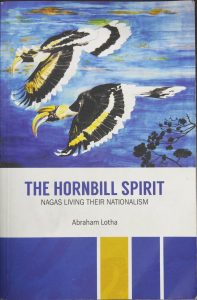
Abraham Lotha
Heritage Publishing House
India, 2016
pp. 347,
Rs.500/US$15.
Abraham Lotha has written widely on Naga history and society. His latest bookThe Hornbill Spirit:Nagas Living Their Nationalismhas two distinctive features that bring freshness to a well-worn subject. It puts Naga nationalism in a broader perspective than any book has done thus far,by framing it in a global context of colonial history, indigenous peoples’ self-determination, and theory of the nation-state, while also managing to trace Naga nationalism’s unique and checkered evolution from the 1929 Naga Club’s memorandum to the Simon Commission, often considered the beginning of Naga nationalism,to the 2015 Framework Agreement between the Indian government and NSCN (IM), whose provisions have been the subject of speculation and rumors in the Naga media and socialcircuits for over a decade. The book’s second salient featureis its ethnographic voice and ambience. It doesn’t surprise that an anthropologist author would use Naga folklore as teachable moments for today’s society or includecommemorative photographic images and the personal stories of everyday peoplein a book of history.What surprises is that the historical narrative also turns out to be a timely andcritically trenchantstudy of Naga nationalism.
The first and last chapters (there are eight in all)introduce and reinforce the present state of the Nagas as a people. As the title suggests, the Nagapredicament isanalogous tothat of the celebrated native bird, the hornbill:colorful, free-spirited, high-flying, youthful,and determined, but constrained by encroachments on its natural habitat and presently limitedby its slow powers of adaptation to the fast changing environment. Likewise, the challenges facing Nagasare real and weighty and present a test of their powers of resilience, and will require of them a concerted effort to muster the strengthand resolve necessary to construct a new future as a people in anincreasingly globalized world. The book is geared by the author’s hope that Nagas can build asocietyconstituted from a combination of two components: the best values in their traditional cultures and the better aspects of an interdependent transnationalworld of the twenty-first century. Abraham Lothafinds no contradiction in the two worlds when it comes to the foundational values and practices of any human society, ethnic or global, which appliesto Indiansand Nagas as distinct yet interconnected peoples as well.
Chapter 4 recounts India’s military occupation of the Naga country,chapter 5 the Naga response to the occupation in the context of life and traditions at the time of the occupation and beyond.They are the heart of the book in more than their just being the middle chapters. They lay out the central events of the Indo-Naga conflict so as to allow both Indians and Nagas to grasp anew the fundamental dignity and equality of all peoples. In practical terms, thatmeans eachhas the right to determine how to govern themselves, an essential part of which is the obligation on the part of both sides to resolve the conflictwith mutual respect and to live in harmony with each other for greater good. This is where Abraham Lotha is at his most persuasive. The Naga insistence on “sovereignty” has been a bone of contention in the conflict. So he argues here, as he has done elsewhere including in The Raging Mithun (2013), that sovereignty is not an all or nothing concept, certainly not a zero-sum political game. He recommends that the Naga nationalist groups and the Indian government review the different models of “shared sovereignty” in operation throughout the world, about which he has written in some detail earlier.
The Hornbill Spiritis a well-researched and documented work from start to finish. A book of this quality on the Indo-Naga conflict is hard to find. It forces the reader to revisit the problem, rethink, most of all,of the needless waste of lives and resources on both sides that the long history of domination and resistance has wrought. It led this reviewer to wonder, on the one hand, how so difficult it has beenfor the Indian government, a leading world democracy, to dropthe argument of colonial devolution in its claim on the Nagas, among whom a democratic culture existed long before Britain and India arrived on the scene, andhow logical it would seem for Indiato adopt a principle of freedom from colonial rule, which was the raison d’etreof India’s own postcolonial existence. On the other hand, the book also leads one to relive the fate the Nagashave had to endure: resisting military occupation of their land, lamenting and protesting their lot,and making a habit of painting themselves into the position of a wronged people, and for so long, they seem to have forgotten how to build themselves up as anation of the proud people they claim to be. After all these decades, the hardest challenge for Nagasaheadwill probably be their economic dependency on India and the problems that come with it.
Abraham Lotha has written extensively about these problems for many years, especially since the publication of his first book History of Naga Anthropology (1832-1947) in 2007. The best thing a good book can do in a situation like the Indo-Naga relation and its impact on the Naga society is to invite both sides to revisit the problem, not so much to undo the losses, which cannot be undone, but to start the hard work of repairing the damage and, more importantly, helping build each other up for a peaceful and prosperous future together. And this is the governing impulse that runs throughoutThe Hornbill Spirit:Nagas Living Their Nationalism.
Paul Pimomo

